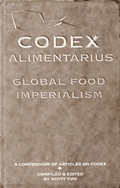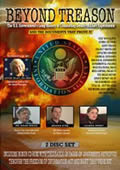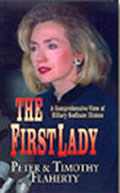BUSH LEGACY: SELLOUT
By
Jon Christian Ryter
January 16, 2009
NewsWithViews.com
Based on the face of it, we can assume that outgoing President George W. Bush failed Geography 101 since the Mariana Trench is about 6,000 miles from Los Angeles. Former presidents, tritely using 34 Stat. 225, 16 USC 431, The Antiquities Act of June 8, 1906 to appease environmentalists and/or oil, gas or mineral rights profiteers, have appropriated valuable land from the citizens of the United States to keep it from being economically exploited, thereby theoretically safeguarding the land for posterity (i.e., their constituents for exploitation by them at some future date) by converting them into national parks, reserves or sanctuaries. For example, on May 26, 1952, shortly after massive oil reserves were discovered along the North Slope of Alaska, President Harry S. Truman issued Executive Order 10355 creating the Arctic National Wildlife Range which was to consume some 8.9 million acres of land sitting directly on top of the most important oil find since the initial discovery of crude oil at Oil Creek, Pennsylvania in 1862 and the Baku Oil Fields in Russia in 1873.
Fearing that the North Slope oil find might trigger a "black gold rush" like the Oil Creek "oil rush" during the Civil War, that could potentially collapse the wholesale price of oil worldwide, lobbyists for the Seven Sisters and the oil industry-financed environment movement petitioned Truman to create a wildlife habitant where oil drilling would be banned. Truman did. Executive Order 10355 called for creating a refuge "...beginning at the intersection of the International Boundary line between Alaska and Yukon Territory, Canada, with the line of extreme low water of the Arctic Ocean in the vicinity of Monument 1 of said International Boundary line, thence westerly along the said line of extreme low water, including all offshore bars, reefs and islands to a point of land on the Arctic seacoast known as Brownlee Point...;" and so forth in minute detail provided by those who possessed accurate knowledge of the size and scope of the oil deposits we know today as ANWR. The Refuge was assigned to the Department of the Interior's US Fish and Wildlife Service. On February 29, 1980, President Jimmy Carter issued Presidential Proclamation 4729 changing the name of the Refuge to the William O. Douglas Arctic Wildlife Refuge. Ten months later Congress legislated the Alaska National Interest Lands Conservation Act of 1980 officially creating the Arctic National Wildlife Refuge and stealing 27.47 million oil rich acres from the people Alaska, and preventing Alaskan entrepreneurs from competing with the Seven Sisters for a slice of the global oil and natural gas pie.
Just as the global banking cartel controls the price of money and the availability of credit by manipulating the fractional reserve to expand and contract the economy at whim, the fossil fuel cartel control the retail prices of all of the world's fossil fuels by manipulating the futures market to expand and contract the supply of crude oil, natural gas and, at the pump, gasoline and home heating oil. When true free enterprise exists, and the bureaucracy is unable to stifle either the free flow of money through State banks and the free flow of goods and commodities, prices drop and the free enterprise economic system works.
In September, 1996, some nine weeks before President Bill Clinton's reelection against Republican challenger and Senate majority leader Bob Dole [R-KS], the 42nd President of the United States paid off Beijing-linked Indonesian banker and businessman Mochtar Riady's for Riady's Lippo Group's illegal contributions to both of Clinton's campaigns, the President invoked the The Antiquities Act of June 8, 1906 to create the Grand Staircase-Escalante National Monument. Without congressional approval, Clinton nationalized 1.7 million acres of the sovereign State of Utah. Clinton stood on the same spot where, in 1908, then President Theodore Roosevelt, citing the same legislation to protect the Grand Canyon from commercial development, by Executive Order banned mining from one of the world's largest known deposits of low sulfur anthracite coal, giving Riady a virtual global monopoly on anthracite coal.
Clinton's decision closed the largest anthracite coal field in the nation—the Kaiparowitz Plateau—which contained, at a bare minimum, 7 billion tons of anthracite coal worth close to one $1.5 trillion in 1996 dollars. The Kentucky-based coal giant, Andalux Resources, held leases on 3,400 acres of coal-rich land in southwest Utah, and was in process of launching a major underground mine that would have generated over 1,000 full time jobs that would have put upwards of $50 million per year into the Kane County, Utah economy. With the land suddenly off limits for anything except tourist photo ops, the jobs dried up and the anthracite coal now being burned in what factories are left in America comes from Indonesia.
Creating the Marianas Trench Marine US National Monument is a legal stretch even for the United States government since, clearly, the Mariana Trench isn't a part of the United States. However, according to Bush's Presidential Proclamation, dated Jan. 6, 2009, the language of 34 Stat. 225, 16 USC 431, The Antiquities Act of June 8, 1906 authorizes the President, "...in his discretion, to declare by public proclamation historic landmarks, historic and prehistoric structures, and other objects of historic or scientific interest that are situated upon lands owned or controlled by the Government of the United States to be national monuments."
While it's clear that the nationalistic, non-empire building 59th Congress did not remotely contemplate that a future president would attempt to create a United States National Monument out of the Mariana Trench Archipelago since the island cluster, which is about 1,500 miles from China, is about 6,000 miles from the United States. Guam is the southern most island in the Mariana Trench Archipelago. There are 14 islands which make up the Commonwealth of the Northern Mariana Islands, a mid-ocean ridge some 1,400 miles from Japan who owned the islands and atolls America won in battle during World War II.
One Mariana Archipelago island is currently under the control of the United States: Guam. Add to that the American Samoa island known as the Rose Atoll and what is collectively known as the "Pacific Remote islands" (Johnston Atoll, Kingman Reef, and Palmyra Atoll in the Mariana Archipelago and Wake. Howland, and Jarvis Islands) which are part of the Hawaiian Archipelago and you have Bush's claim of sovereignty over 335,561 square miles of the Pacific Ocean on behalf of the World Wildlife Fund and the Pew Foundation. However, there's another flaw in Bush's reasoning.
In 1979 (before he gave away the Panama Canal), President Jimmy Carter ceded part of the Stewart Island chain (Washington Island, Fanning island, Makin Island, and Makin Atoll) to Kiribati. In an attempt to outdo Carter, the Clinton-Gore Administration abandoned the rest of the Pacific outposts taken by the United States during World War II except Midway and Wake Island. Clinton Secretary of State Madeleine K. Albright struck the colors and abandoned the islands and atolls Bush-43 claimed to be part of the his "Pacific Remote Islands:" Baker, Howland, Jarvis, Nassau and Palmyra islands, Kingman Reef and Johnston Atoll. Which, of course, is probably why Bush chose to refer to them as the "Pacific Remote Islands" instead of their names since that might be confusing to some people since China now claims some of them even though they were Japanese possessions when we liberated them.
Since 2006 the Pew Foundation's Environment Group's Global Ocean Legacy Program worked directly with the Bush-43 Administration to create a large-scale marine reserve in the waters of the Mariana Trench Archipelago. According to Bush's proclamation, Baker, Howland and Jarvis Islands were formed some 75 to 120 million years ago as fringing reefs by Cretaceous Era volcanoes. Deep coral forests descend to great depths below the photic zones. The Pew Environmental Group claims it wants to preserve the natural unspoiled nature of these waters like the volcanic undersea vents (called smokers) that bubble with liquid carbon dioxide. The Pew Foundation wanted a United States national marine reserve in the Mariana Trench and Bush was as accommodating as a retiring president can be.
Resisting Bush's effort to create the marine reserve under the Antiquities Act was the National Marine Manufacturer's Association for a variety of reasons, least of which is the fact that the Mariana Archipelago simply is not part of the United States of America. NMMA believes the proclamation bypasses long-standing peer review and public comment. Peer review and public comment would have been part and parcel of the process if Congress had decided to enact the Marianas Trench Marine National Monument into law. They didn't because it would have been a piece of legislation attacked by everyone since it exceeded the authority of the lawmaking body of the United States. Of course, since Bush's edict is a proclamation and not a law, peer review or public comment was not needed.
While the advocates of governance by executive decree are quick to point out that every president since George Washington has issued Executive Orders and/or Presidential Proclamations, few will acknowledge that, prior to FDR, presidential proclamations were used solely to designate special days—like Mother's Day, or Thanksgiving. Executive orders are instructions from the "boss" to his employees in the Executive Branch. Neither carries the force of law because, constitutionally, the President of the United States has no legislative power and cannot create law. Nor does he possess the judicial power to enforce his edicts. Again, at the risk of being repetitious, every Congressman and Senator on the other end of Pennsylvania Avenue is well aware of that fact. They have chosen to tolerate presidential excursions into totalitarianism with barely a whimper of outrage because presidents "legislate" the agendas of the overlords of life who manipulate nations from behind the seats of government and not in them. Laws which elected politicians could never successfully legislate and keep their jobs are fast-tracked into the US Code by Executive Order, Presidential Proclamation and Presidential Decision Directives which violate the constitutional separation of power between the Executive, Legislative and Judicial branches of government, and they infringe on the separation of power between the States and the central government by violating the 10th Amendment.
When Congressman Jack Metcalf [R-WA], who died at age 79 on March 15, 2007, sponsored House Concurrent Resolution 30 in 1999, the left slated him for removal. Metcalf was defeated in his reelection bid in November, 2000. Resolution 30 stated that whenever a president issued an Executive Order that exceeded his constitutional authority, Congress would notify the White House it had received the President's "advisory memo" and, without making any promises to enact it, would take it under advisement.
When Bill Clinton issued an Executive Order banning smoking in all federal government offices, then Senate Majority Leader Bob Dole sent a terse note to the White House reminding Clinton that Executive Orders are nothing more than interoffice memos from an employer (the President) to his employees (the Executive Branch of government), so while the President could mandate that his employees could not smoke in the office buildings under his jurisdiction (the Executive Branch), he had no authority to issue edicts to either the Legislative or Judicial Branches of government. While the White House offices (excluding Clinton's office) became a smokefree zone, the smoking lamp remained lit on the other end of Pennsylvania Avenue.
The approach the NMMA should have taken was simply to denounce the Presidential Proclamation as just so much 'who shot John." Instead, the NMMA treated like it was a legitimate exercise of presidential power. In their press release, they said: "We are disappointed about this new effort to restrict pubic access to marine resources held in the public trust without a proper review process. This new designation needlessly prohibits recreational angling in vast areas of the ocean without any scientific basis, and sends the wrong signal that angling is a threat to the environment...As we move forward, we are hopeful that President-elect Obama and his administration will abandon this model of managing marine resources and look to the angling, boating and conservative communities as partners in environmental stewardship..."
The total area of the Mariana Trench archipelago is about 190 thousand square miles of sea and sea floor. Bush's proclamation protects 95,222 square miles, or about 45% of the archipelago. Bush nationalized 13,451 square miles of seabeds in the Rose Atoll and 86,607 square miles to protect the seven islands and atolls in the Pacific Remote Islands Monument. What supposedly made Bush's seabed snatch legal was not legitimate claims of ownership to the islands archipelago systems by the United States but the implementation of the 1982 Convention on the Law of the Sea [LOST] which went into force on Nov. 16, 1994 and allowed the major nations who could enforce their will, to establish and control exclusive marine zones on behalf of the world's largest environmental groups. Neither Ronald Reagan nor George H.W. Bush would sign the treaty. Reagan was concerned about the rights of nations to conduct deep seabed mining. On Jan. 29, 1982 Reagan issued a statement expressing his intent not to sign LOST. In a prepared text, he said: "While most provisions of the draft convention are acceptable and consistent with United States interests, some major elements of the deep seabed mining regime are not acceptable.." When he testified before Congress, Reagan's Deputy Secretary of State, John Negroponte testified that Reagan's misgivings were solely "...due to deep flaws in the seabed mining chapter—Part XI of the Convention..." suggesting that if that provision had been removed, Reagan would have signed it. In his personal diary on Tues., June 29, 1982, (published in the book The Reagan Diaries (edited by Douglas Brinkley, Regnery © 2007; pg 91) Reagan noted: "Decided in NSC meeting—will not sign "Law of the Sea" treaty even without seabed mining provisions." On Oct. 13, another diary entry shows that Reagan sent Bush-43 Defense Secretary Donald Rumsfeld to convince our allies in Europe and Asia to join the United States in rejecting LOST. Rumsfeld's mission was successful. LOST went on the back burner until Bill Clinton won the White House with illegal Chinese campaign contributions.
The Clinton-Gore Administration had no such misgivings. Bill Clinton signed the Law of the Sea Treaty in October, 1994, he said, to protect endangered sea turtles. Clinton revived a treaty that had already been declared dead. The GOP-controlled Congress refused to ratify the treaty, believing it would die even though Clinton (who claimed he fixed it even though he didn't) was the 154th head of State to sign LOST. The treaty was activated with his signature. The little known 300-plus year old International Law of the Nations mandates that when the leader of a nation (president, prime minister, or even Foreign Minister or Secretary of State signs a treaty on behalf of his or her nation, under the terms of the Law of the Nations, the treaty is deemed to ratified by the world community.
The seabed regulations have created a bizarre regulatory regime which is antagonistic to commerce, exploration and investment. LOST treats the ocean's "unowned" seabed resources as property of the United Nations. The same happens with mineral wealth in the seabeds of the protected marine reserves. LOST created a new power structure in the UN—the International Seabed Authority to govern deep seabed mining. In addition, the Seabed Authority Council would mine the ocean floor with the coerced help of Western mining companies on behalf of the Authority and would then redistribute the income generated from the project from the industrialized nations to the developing countries. In doing so, LOST seeks to discourage future mining schemes and punish those entrepreneurs by seizing the revenues earned from the seabed mining ventures. LOST would discourage seabed exploration of other unowned seabed resources.
In the seabeds around the Mariana Trench and Rose Atoll National Monuments, geologists have identified hard minerals like phosphorite, abyssal manganese, ferromanganese, cobalt, sulfide, olivine, feldspar, clinopyroxene, opaline, silica, and pyrite as well as hydrathermal deposits of gold and silver and the world's richest deposits of baryte (barite). In addition, under the seabeds in the Pacific Remote Islands is the world's largest oil and natural gas reserves. Preliminary estimates suggest the oil and natural gas reserves under the Pacific Remote Islands Monument will dwarf the combined reserves under the North Slope or Alaska and the Arabian Peninsula.. In 2005 Standard Oil entered into an IPO with China National Oil [CNOOC] to further explore and develop the oil and natural gas deposits in the seabeds under the Pacific Remote Islands Monument and the Rose Atoll Monument.
Clearly, the purpose of nationalizing 335 thousand square miles of the South Pacific seabeds was to place thousands of miles of unowned seabeds off limit by preventing entrepreneurial oil speculators from tapping into some of the richest oil and natural gas properties in the world. While this application of LOST converts lands, and seabeds owned by the Commonwealth of the Northern Mariana Islands and American Samoa and, to a minor degree, Hawaii, US federal law, under LOST, is applicable to stop anyone from exploiting the pristine, unspoiled and biologically diverse sea habitat.
|
Subscribe to the NewsWithViews Daily News Alerts! |
The Coral Reef Alliance believes outgoing President George W. Bush has created his legacy as a President who has done more to protect the environment of the seas than any other President. Somehow, I doubt if former President Ronald Reagan would agree with their assessment.

















